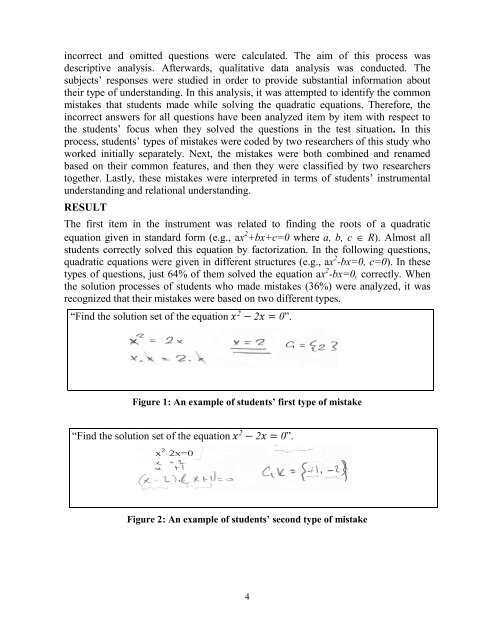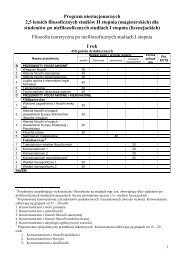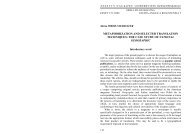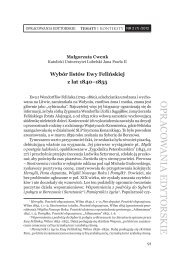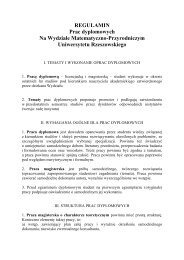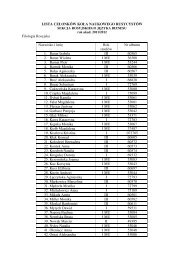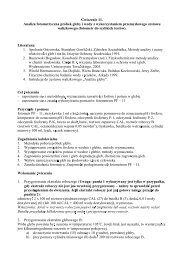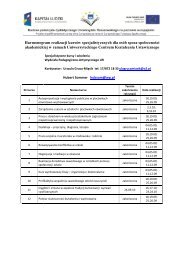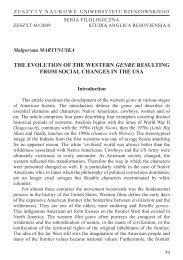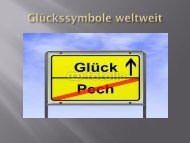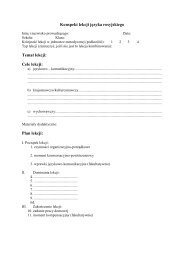<strong>in</strong>correct and omitted questions were calculated. The aim of this process wasdescriptive analysis. Afterwards, qualitative data analysis was conducted. Thesubjects’ responses were studied <strong>in</strong> order to provide substantial <strong>in</strong>formation abouttheir type of understand<strong>in</strong>g. In this analysis, it was attempted to identify the commonmistakes that students made while solv<strong>in</strong>g the <strong>quadratic</strong> <strong>equations</strong>. Therefore, the<strong>in</strong>correct answers for all questions have been analyzed item by item <strong>with</strong> respect tothe students’ focus when they solved the questions <strong>in</strong> the test situation. In thisprocess, students’ types of mistakes were coded by two researchers of this study whoworked <strong>in</strong>itially separately. Next, the mistakes were both comb<strong>in</strong>ed and renamedbased on their common features, and then they were classified by two researcherstogether. Lastly, these mistakes were <strong>in</strong>terpreted <strong>in</strong> terms of students’ <strong>in</strong>strumentalunderstand<strong>in</strong>g and relational understand<strong>in</strong>g.RESULTThe first item <strong>in</strong> the <strong>in</strong>strument was related to f<strong>in</strong>d<strong>in</strong>g the roots of a <strong>quadratic</strong>equation given <strong>in</strong> standard form (e.g., ax 2 +bx+c=0 where a, b, c R). Almost allstudents correctly solved this equation by factorization. In the follow<strong>in</strong>g questions,<strong>quadratic</strong> <strong>equations</strong> were given <strong>in</strong> different structures (e.g., ax 2 -bx=0, c=0). In thesetypes of questions, just 64% of them solved the equation ax 2 -bx=0, correctly. Whenthe solution processes of students who made mistakes (36%) were analyzed, it wasrecognized that their mistakes were based on two different types.“F<strong>in</strong>d the solution set of the equation 2 − 2 = 0”.Figure 1: An example of students’ first type of mistake“F<strong>in</strong>d the solution set of the equation 2 − 2 = 0”.Figure 2: An example of students’ second type of mistake4
“F<strong>in</strong>d the solution set of the equation “ 2 − = 12”Figure 3: An example of students’ mistake when just the form of equation changed.In the first type of wrong solution (see Figure 1), students carried the term -2x fromleft side to the right, and then simplified the term x <strong>in</strong> both sides of the equation.Consequently, they ignored <strong>one</strong> of the roots of the equation, which is 0. In the secondtype of wrong solution (see Figure 2), students tried to factorize the equation. Here,students perceived the form ax 2 -bx=0 just like ax 2 +bx+c=0 and thought -2x as theconstant term of the <strong>quadratic</strong> <strong>equations</strong>. Even, when just the form of the equationwas changed <strong>in</strong>stead of the structure (e.g., ax 2 +bx=c where a, b, c≠0), 12% of thestudents <strong>in</strong>correctly solved the <strong>quadratic</strong>. Because the constant term was <strong>in</strong> the rightside, they didn’t perceive that the equation was <strong>in</strong> standard form (see Figure 3). Inthis type of solution, they were able to f<strong>in</strong>d only <strong>one</strong> of the roots, 4.StatementsQuestion 5To solve the equation“(x-3)∙(x-2) = 0”for real numbers, Alianswered <strong>in</strong> a s<strong>in</strong>glel<strong>in</strong>e that:“x=3 or x=2”Is this answercorrect? If it is correct,how can you show itcorrectness?Students’ types of responses <strong>with</strong> their <strong>reason<strong>in</strong>g</strong>I. II. III. IV.“The answer isRight”S<strong>in</strong>ce I wrote(x-3)∙(x-2) = 0as x 2 -5x+6=0and then I factorizeto f<strong>in</strong>d roots of it.from (x-3)=0 andfrom (x-2)=0“x=3 and x=2”Table 1: Common examples of students’ types of responses <strong>with</strong> their <strong>reason<strong>in</strong>g</strong> forquestion 5.Although all of the students stated that Ali’s answer was correct by choos<strong>in</strong>g either<strong>one</strong> of the statements I, II, III, and IV, the ways they justified for the correctness ofAli’s solution were different. For <strong>in</strong>stance, <strong>in</strong> statement I, students first transformedthe factorized expression <strong>in</strong>to the standard form, and then factorized the expressionaga<strong>in</strong> <strong>in</strong> the same way and found the roots by rote. In statement II, studentsunconsciously applied the null factor law. In statement III, the way of justification forsolution was based on substitution method. In all of these three statements, they couldnot clearly justify the correctness of the solution. In statement IV, students substitutedx=3 <strong>in</strong>to (x-3) and x=2 <strong>in</strong>to (x-2) simultaneously, and concluded that their solution5“The answeris Right”Because(x-3)=0(x-2)=0x=3x=2“Theanswer isRight”.S<strong>in</strong>ce wesubstitute“3 and 2”<strong>in</strong>to x, theequation isprovided.(explanationmade only<strong>with</strong> words)“The answer isRight”.If the x=2and x=3 aresubstituted <strong>in</strong>tothe equation(3-3)⋅ (2-2)=00.0 = 0


